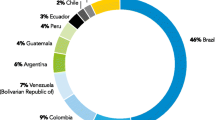Abstract
The objectives of this paper were to identify the types of sexual partners and condom use of migrant workers. Data for the study were drawn from a survey of 3,426 migrant workers in southern coastal and northern areas of Thailand conducted in 2004. Among sexually active men, 25% reported visiting a sex worker, 57% reported a regular partner, and 6% reported another non-regular partner in the last year. Reported condom use was high with sex workers (79% reported always use), but low with regular partners (4% ever use). Factors related to visiting sex workers included marital status (more visits if not married), longer residence in Thailand, occupation of seafarer or seafood production worker, Cambodian origin, and perceived AIDS risk. Condom use with sex workers was higher for younger men, married men, men who had been in Thailand longer, men with lower perceived AIDS risk, and men who drank alcohol less frequently.
Similar content being viewed by others
References
Bandura, A. (1994). Social cognitive theory and exercise of control over HIV infection. In R. J. Di Clemente (Eds), Preventing AIDS: Theories and methods of behavioral interventions. (pp. 25–60). New York: Plenum.
Buffim, J. (1988). Substance use and high risk sexual behavior: Drugs and sex—The dark side. Journal of Psychoactive Drugs, 20, 165–168.
Busza, J., & Baker, S. (2004). Protection and participation: An interactive programme introducing the female condom to migrant workers in Cambodia. AIDS Care, 16, 507–518.
Catania, J. A., Kegeles, S. M., & Coates, T. J. (1990). Towards an understanding of risk behavior: An AIDS risk reduction model (ARRM). Health Education Quarterly, 17, 53–72.
Chamrathrithirong, A., Boonchalaski, W., & Yampeka, P. (2005). Prevention of AIDS among migrant workers in Thailand (PHAMIT): The baseline survey 2004. Nakhon Pathom: Institute for Population and Social Research, Mahidol University.
Cooper, M. L., & Orcutt, H. K. (2000). Alcohol use, condom use, and partner type among heterosexual adolescents and young adults. Journal of Studies on Alcohol, 61, 413–419.
Cooper, M. L. (2002). Alcohol use and risky sexual behavior among college students and youth: Evaluating the evidence. Journal of Studies on Alcohol, 14, 101–117.
Critchlow, B. (1986). The powers of John Barleycorn: Beliefs about the effects of alcohol on social behavior. American Psychologist, 41, 751–764.
He, N., Detels, R., Zhu, J., Chen, Z., Fang, Y., Zhang, X., et al. (2005). Characteristics and sexually transmitted diseases of male rural migrants in a metropolitan area of Eastern China. Sexually Transmitted Diseases, 32, 286–292.
Leigh, B. (1990). The relationship of sex related alcohol expectancies to alcohol consumption and sexual behavior. British Journal of Addiction, 85, 919–928.
Leigh, B. C. (2002). Alcohol and condom use. A meta-analysis of event-level studies. Sexually Transmitted Diseases, 29, 476–482.
Leigh, B. C., & Stall, R. S. (1993). Substance use and risky sexual behavior for exposure to HIV. Issues in methodology, interpretation, and prevention. American Psychologist, 48, 1035–1045.
Lyttleton, C., & Amarapibal, A. (2002). Sister cities and easy passage: HIV, mobility and economies of desire in a Thai/Lao border zone. Social Science and Medicine, 54, 505–518.
Nishigaya, K. (2002). Female garment factory workers in Cambodia: Migration, sex work, and HIV/AIDS. Women and Health, 35, 27–42.
Poudel, K. C., Jimba, M., Okumura, J., Joshi, A. B., & Wakai, S. (2004). Migrants’ risky sexual behaviors in India and at home in far western Nepal. Tropical Medicine and International Health, 9, 97–103.
Rosenstock, I. M., Strecher, V. J., & Becker, M. H. (1994). The health belief model and HIV risk behavior change. In R. J. DiClemente (Eds), Preventing AIDS: Theories and methods of behavioral interventions. (pp. 5–24). New York: Plenum.
Smith-Estelle, A., & Gruskin, S. (2003). Vulnerability to HIV/STIs among rural women from migrant communities in Nepal: A health and human rights framework. Reproductive Health Matters, 11, 142–151.
Stall, R., & Leigh, B. (1995). Understanding the relationship between drug or alcohol use and high risk sexual activity for HIV transmission: Where do we go from here? Addiction, 89, 131–134.
Trocki, K., & Leigh, B. C. (1991). Alcohol consumption and unsafe sex: A comparison of heterosexual and homosexual men. Journal of Acquired Immune Deficiency Syndrome, 4, 981–986.
United Nations. (2006). 2006 United Nations report on the global AIDS epidemic. Geneva: United Nations.
United Nations Development Programme. (2004). Thailand’s response to HIV/AIDS: Progress and challenges. Bangkok: United Nations.
Zuckerman, M. (1990). The psychophysiology of sensation seeking. Journal of Personality, 58, 313–345.
Acknowledgments
This project was supported by funding from the Institute for Population and Social Research, Mahidol University, and the Global Funds to Fight AIDS, Tuberculosis, and Malaria (GFATM): The Global Fund Program on AIDS (GPA).
Author information
Authors and Affiliations
Corresponding author
Rights and permissions
About this article
Cite this article
Ford, K., Chamrathrithirong, A. Sexual Partners and Condom Use of Migrant Workers in Thailand. AIDS Behav 11, 905–914 (2007). https://doi.org/10.1007/s10461-007-9207-x
Received:
Accepted:
Published:
Issue Date:
DOI: https://doi.org/10.1007/s10461-007-9207-x




